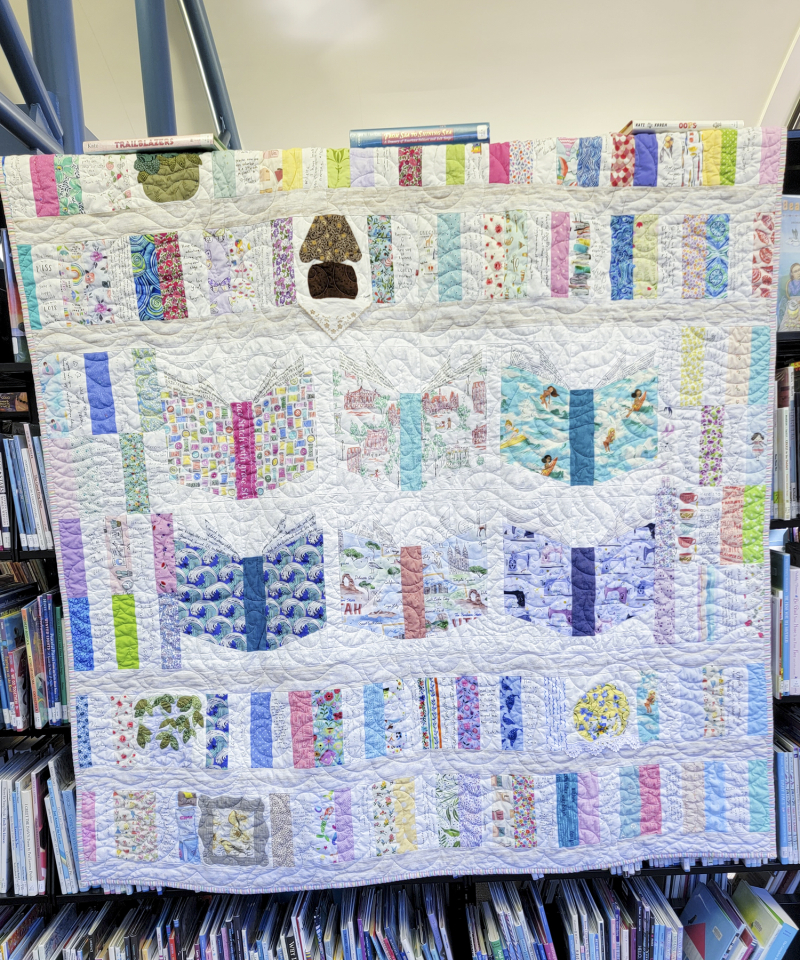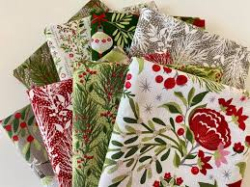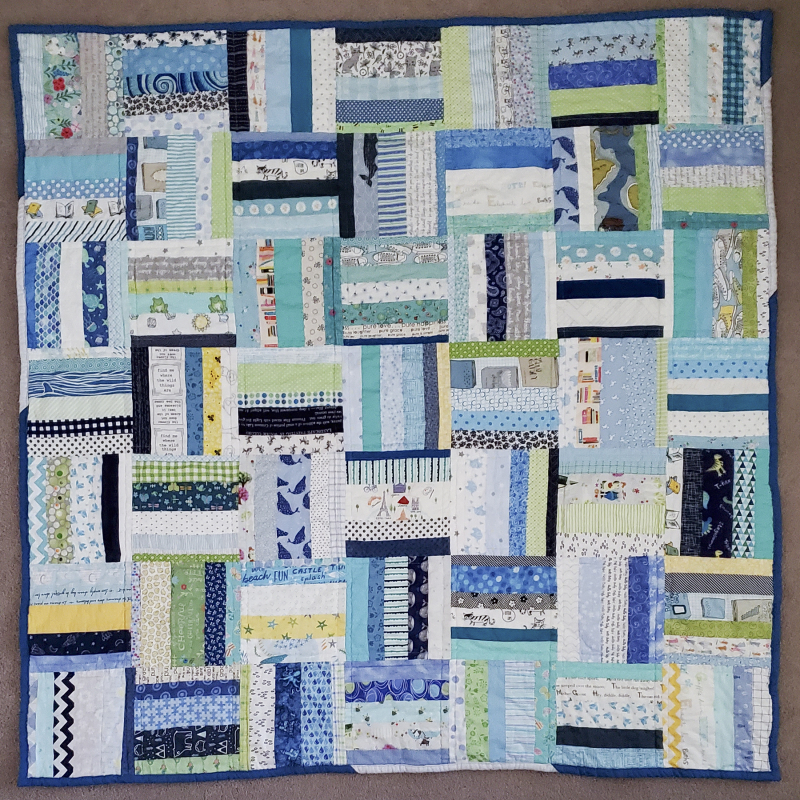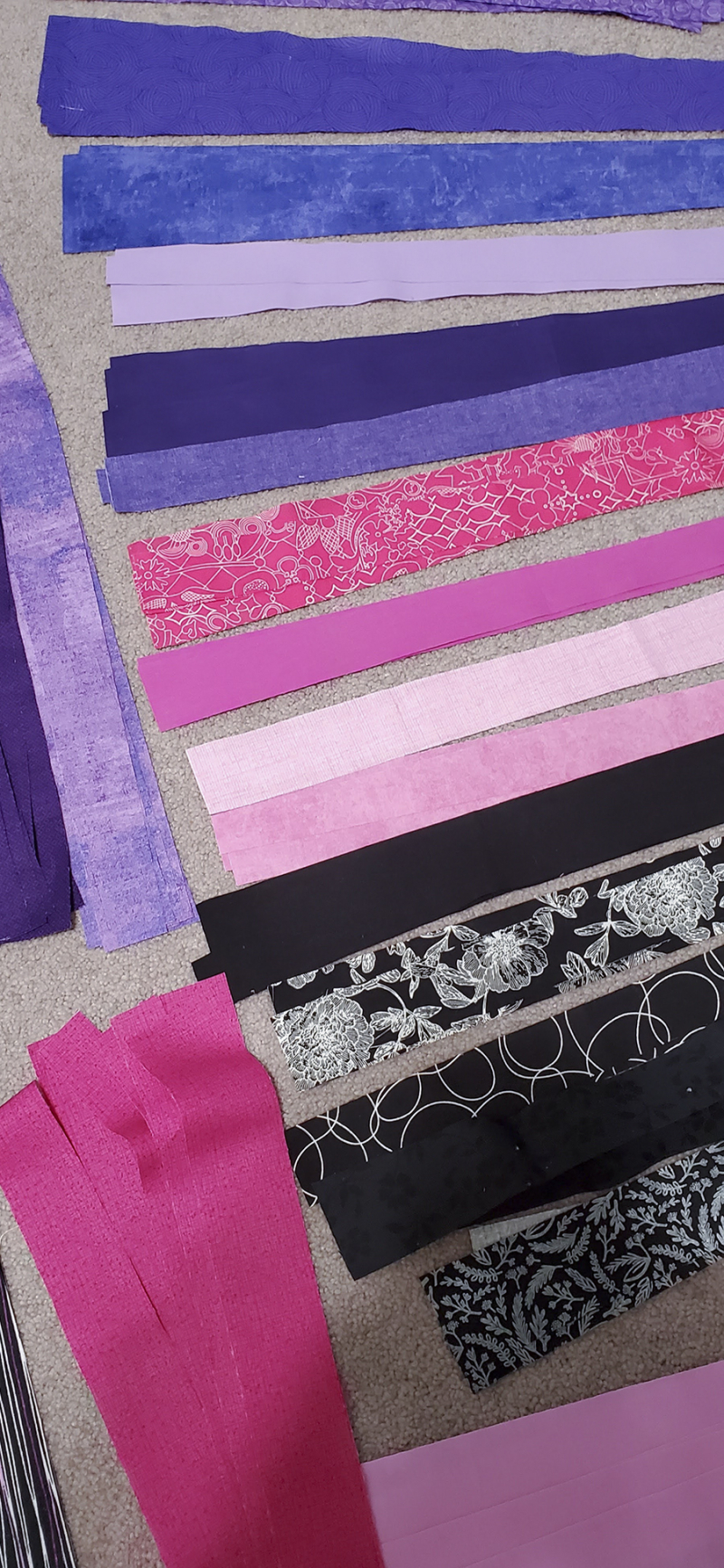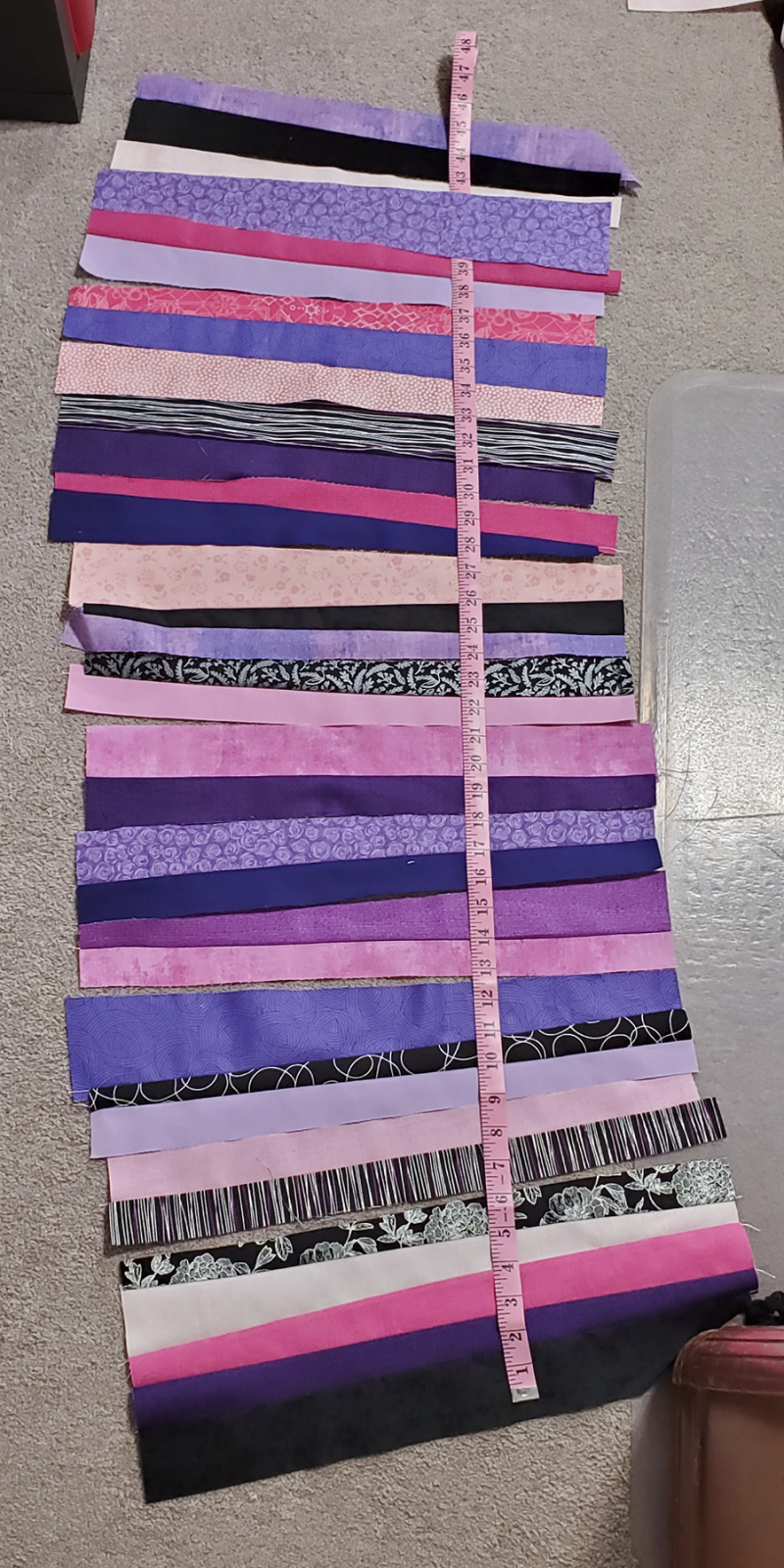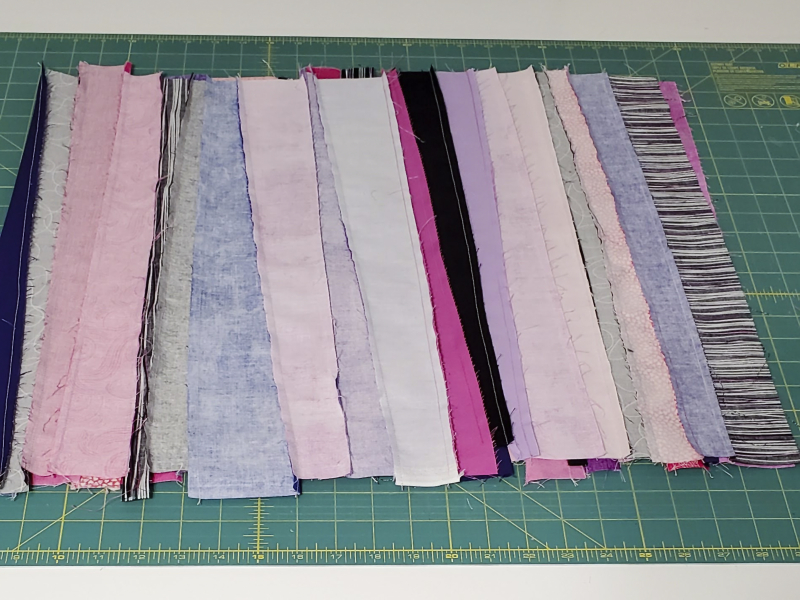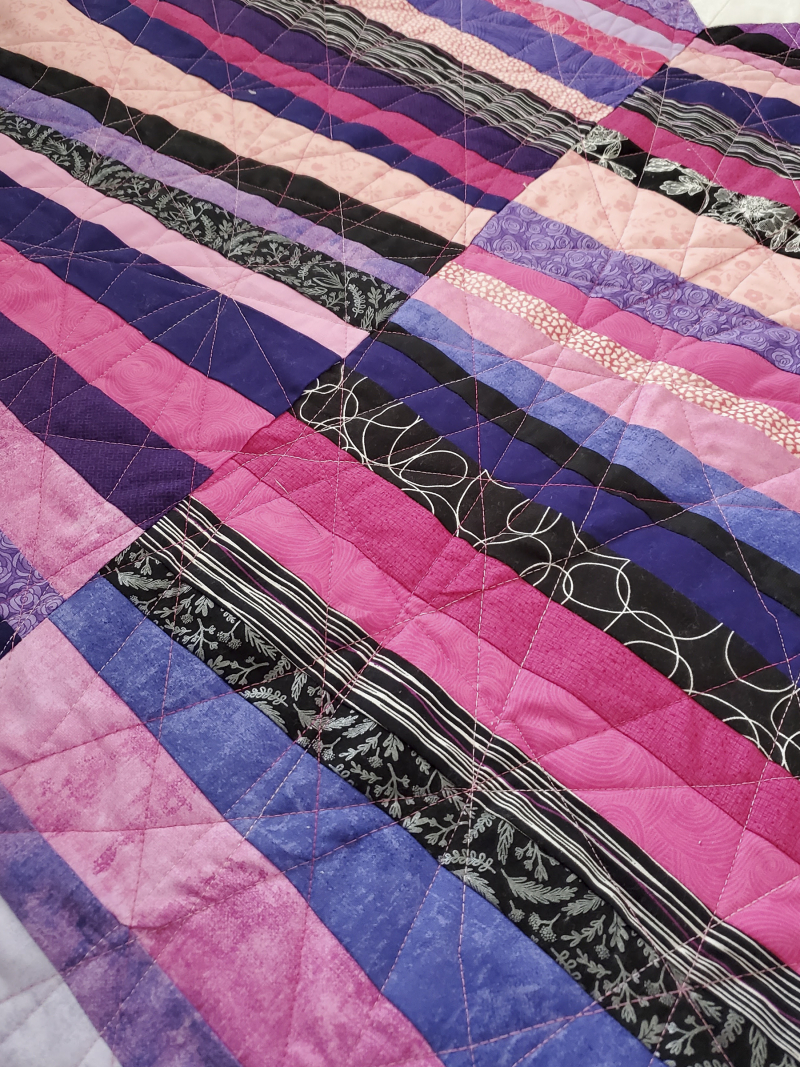Signature Memory Quilt: Notes, Ideas, and Thoughts on a Retirement Gift
Wednesday, June 29, 2022
This month, one of my favorite library coworkers is retiring. I decided I needed to make a quilt for her as a retirement gift. I wanted it to be a sort of memento to represent all of her years at the library, personalized by as many coworkers as possible. At first I thought of gathering favorite quotes from coworkers about books, reading, libraries, friendship, memories. I imagined formatting them all in Photoshop and then having them printed on cotton and…it seemed that would be lovely but overwhelming, and coupled with the fact that this coincided with me transitioning to working full time and, yeah. I abandoned that idea.
Instead I started with this sketch:
So, my basic idea was a center panel of books, with rows of book spines, some of them of printed fabric, some of them signed by coworkers.
And here's how it ended up turning out:
I cut a bunch of 7.5" x 2.5" strips. I was working with a vague idea of how it might all actually come together, so I estimated I would need 50 6"x7.5 squares, (2 printed strips surrounding one white one with the signature(s) of coworkers). I ended up needing way more, which I added to the sides of the center panel. I think I ended up with 75 signed strips.
I made the books in the center panel using the Book Nerd pattern from Angela Pingel. It is a paper piecing pattern and these blocks were super fun to put together. I changed the pattern by enlarging it overall and then making the books wider. For these books, I tried to pick fabrics that both represented things my friend loves (the ocean, sewing, books, travel) and fit into the general scrappy-pastel color scheme. The fabric with images from Utah was a last-minute discovery from Joann and I was so happy to find it! (Even though I don’t, I confess, often use fabric from Joann, as the last time I did the result was a dye-bleed disaster.) I meant to make two rows of five books but the addition of the spines on the side meant I just had room for three.
When I finally got everything ready and put it together, I did have to take away some of the colored strips to have space for all of the signature strips. I was planning on the quilt being 60" wide but it ended up at 64" (ish), which is close enough. It took some scootching and some of the spines are trimmed down, but I think that’s OK because of course all book spines aren’t the same width.
One of my friends who also quilts, and who also used to work with us at the library, made the five appliqued squares: two plants, a lamp, a cup of tea, and a framed picture. That kind of square is NOT my forte so I was so happy to have her addition. I think they were the perfect finishing touch to bring everything together.
A few process tips for making a signature memory quilt:
- Prewash the plain cotton you want people to sign. This will help the ink saturate the fabric more deeply.
- Use a high-quality cotton. I used Kona Snow for mine. Avoid fabric that has much obvious texture as it will make the writing bumpy—the smoother the better!
- Use NEW markers. I used Micron Pigma pens because I have two quilts my mother-in-law made for my boys, and she signed them with these markers. Dozens and dozens of washes later, her signature is still there. You might have some lying around, especially if you do other crafts, but get new ones for the quilt. They write so much easier and darker when they are new.
- Heat set every block before you sew them all together. The heat will also help set the ink.
I backed the quilt with this fabric. Isn’t it perfect!!! (Another confession, I might’ve made the whole quilt simply because I wanted to use THAT fabric for a friend who loves books as much as I do.)
It’s called Book Shelves, by Caitlin Wallace Rowland/Dear Stella and of this writing it’s still available. I got mine at Hawthorne Fabrics.
The quilting was done by Sew Shabby quilting. I was worried about this part because I thought the words people had written would be covered by the quilting. She arranged it perfectly, though, so you could still read all of the words. She has a lovely wool batting so I had her use that. It’s light and fluffy and I love it!
This was the first time I’ve made a memory quilt like this. Some things I learned:
- I was pretty terrified when I washed it that the signatures and notes would fade away, but most of them were OK. I had a variety of pen thicknesses, but if I do another quilt like this I will only have .5 and .8 pens. The thinner ones did get a bit harder to read when I washed it. I also learned that fine-tipped Sharpies are OK for this kind of project.
- I had the 6 x 7.5 squares already sewn together, so the left and right seam allowances were already taken care of. Even though I told people to write at least ¼" from the top and bottom, a few people bumped into the seam allowances. Next time I’ll draw pencil lines on all of the signature strips to help out with that. Also, I had a spare piece of the white cloth for people to practice writing with the pens, which I think helped. Writing on fabric is not like writing on paper!
- I wanted to collect signatures and notes from coworkers who don’t work at the library anymore, as well as current ones. This was a lot of mailing, worrying about mail, and one that didn’t get back in time. I definitely did NOT allow enough time and it was a little bit stressful in the end to make sure it was finished by the time of the retirement party. But, it was really fun to see and communicate with people who I hadn’t in awhile.
- I was surprised at how many people were very reluctant to write anything more than their name. I tried to just give them space so I wasn’t reading over their shoulder when they wrote. I also told them it was SO not a big deal if they messed up. That’s what seam rippers are for! I also encouraged them to not worry about their handwriting. As long as it is legible, it is great!
I got to give the quilt to my friend last Tuesday. I think she loved it and I hope it helps her remember how loved and valued she was at the library. And how much she will be missed.
(And, I have to say: I’m pretty proud of myself for getting an entire quilt finished while I was also working full time and recuperating from surgery. I can do difficult things!)

